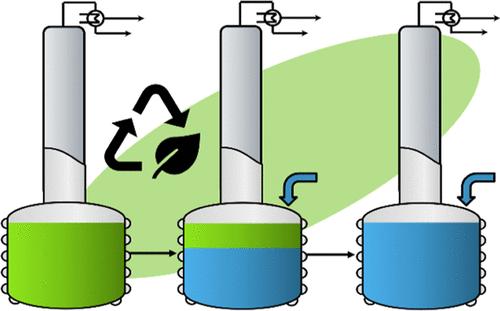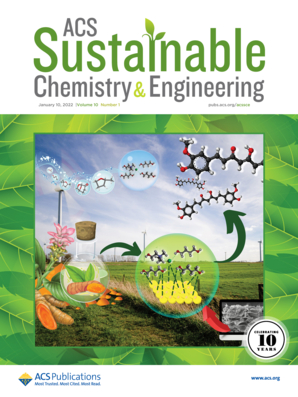Resource-Efficient Solvent Utilization: Solvent Selection Criteria Based on Solvent Swap Characteristics
IF 7.1
1区 化学
Q1 CHEMISTRY, MULTIDISCIPLINARY
引用次数: 0
Abstract
Several solvent selection guides were developed and published in the past, which take health, safety, and environmental aspects into account. Despite their valuable contribution to more sustainable solvent use in chemical manufacturing, the evaluations of these guides are essentially based on the characteristics of pure solvents. However, since also mixtures of solvents are often handled in a multistep manufacturing process, such a pure solvent evaluation often falls short since it does not capture important process-intrinsic aspects. To improve the preselection of solvents, we provide in this contribution new supplemental process-related indicators which quantify the effort arising from a solvent swap procedure considering the separability of mixtures of solvents. These new separation feasibility indicators (SFIs) are based on calculations which not only account for real (nonideal) thermodynamic properties of binary solvent mixtures but also include three key results of a simulated “standard” solvent swap procedure: the number of solvent swap steps needed to achieve the required purity, the specific mass of lost swap solvent, and the required specific energy of the solvent swap procedure. The calculations were carried out for 57 solvents that are commonly used in the pharmaceutical industry or currently discussed as “green solvents” in recent publications. These 57 solvents yield 1596 binary solvent mixtures and 3192 possible solvent swap combinations. We demonstrate with specific examples that simple evaluations based on boiling point comparisons or relative volatilities can be misleading in the preselection of solvents. The classification of solvent combinations based on the calculated SFIs aids in the design of a resource-efficient manufacturing process in terms of solvent and energy consumption already at an early stage of process development, supporting a “first-time-right” approach with limited additional effort.

资源高效溶剂利用:基于溶剂交换特性的溶剂选择标准
过去制定和出版了一些溶剂选择指南,这些指南将健康、安全和环境因素考虑在内。尽管它们对化学制造中更可持续的溶剂使用作出了宝贵贡献,但对这些指南的评价基本上是基于纯溶剂的特性。然而,由于溶剂的混合物通常在一个多步骤的制造过程中处理,这样的纯溶剂评价往往是不足的,因为它没有捕捉到重要的工艺内在方面。为了改进溶剂的预选,我们在本贡献中提供了新的补充工艺相关指标,这些指标量化了考虑溶剂混合物可分离性的溶剂交换过程所产生的努力。这些新的分离可行性指标(sfi)基于计算,不仅考虑了二元溶剂混合物的真实(非理想)热力学性质,而且还包括模拟“标准”溶剂交换过程的三个关键结果:达到所需纯度所需的溶剂交换步骤数,丢失的交换溶剂的比质量,以及溶剂交换过程所需的比能。这些计算是针对57种溶剂进行的,这些溶剂通常用于制药工业,或者在最近的出版物中被讨论为“绿色溶剂”。这57种溶剂产生1596种二元溶剂混合物和3192种可能的溶剂交换组合。我们用具体的例子证明,基于沸点比较或相对挥发性的简单评估在溶剂的预选中可能会产生误导。根据计算的sfi对溶剂组合进行分类,有助于在工艺开发的早期阶段就溶剂和能源消耗设计资源高效的制造工艺,支持“第一次正确”的方法,而额外的努力有限。
本文章由计算机程序翻译,如有差异,请以英文原文为准。
求助全文
约1分钟内获得全文
求助全文
来源期刊

ACS Sustainable Chemistry & Engineering
CHEMISTRY, MULTIDISCIPLINARY-ENGINEERING, CHEMICAL
CiteScore
13.80
自引率
4.80%
发文量
1470
审稿时长
1.7 months
期刊介绍:
ACS Sustainable Chemistry & Engineering is a prestigious weekly peer-reviewed scientific journal published by the American Chemical Society. Dedicated to advancing the principles of green chemistry and green engineering, it covers a wide array of research topics including green chemistry, green engineering, biomass, alternative energy, and life cycle assessment.
The journal welcomes submissions in various formats, including Letters, Articles, Features, and Perspectives (Reviews), that address the challenges of sustainability in the chemical enterprise and contribute to the advancement of sustainable practices. Join us in shaping the future of sustainable chemistry and engineering.
 求助内容:
求助内容: 应助结果提醒方式:
应助结果提醒方式:


